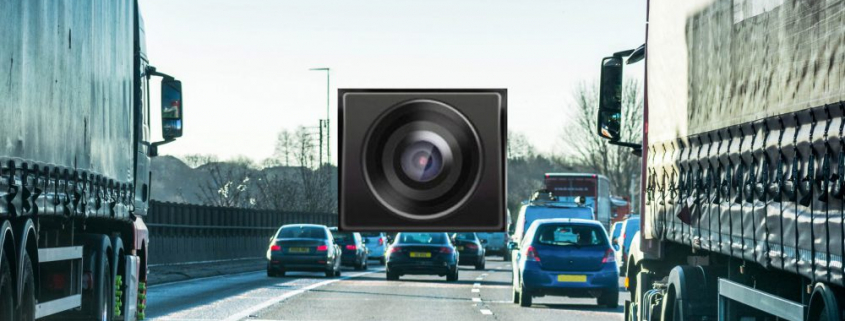Are you ready for Direct Vision Standard 2020?
What all fleet managers need to know!
What is the Direct Vision Standard (DVS)?
The Direct Vision Standard is changing our attitude towards how we regard public safety on our roads in urban areas. Further, it is a guiding light on how helpful camera technologies can be put to use in multiple ways to protect against incidents, secure vehicles and their loads and optimise fleet management. Advanced operators have been implementing many of these techniques to help improve operations and cut costs but now Transport for London (TfL) is looking to enforce practices within the M25. An HGV Safety Permit will be required for HGVs of 12 tonnes gross vehicle weight (GVW) and over from the 26th October 2020 or risk a £550 fine per incident.
The Freight Transport Association (FTA) estimates that over 60% of all HGVs over 12 tonnes GVW will be banned from entering London without a permit. To get this permit, first you need to know the star rating of your HGVs, which will dictate what, if any, of TfL’s recommended safety equipment needs to be installed on them. Once the equipment has been installed you can start the permit application process, which is free.
Star rating for direct vision
The HGV Safety Permit scheme will cover greater London and be in operation 24 hours a day, every day of the year. Permits will only be granted for vehicles that meet the minimum DVS star rating. Vehicles that don’t meet the minimum DVS star rating will need to be fitted with Safe System improvements. The standard applies to both right–hand and left–hand drive vehicles and includes those from outside of the UK.
A star rating will be applied to all vehicles based on the driver’s direct field of view, in order to reduce the risk of close proximity blind spot collisions. You can register any of your vehicles for a star rating here, which will provide you with a list of safety equipment that you need to install for each vehicle on your fleet.
Research has shown that direct vision is the key factor in improving public safety in urban areas. Although vehicle manufacturers are developing new models that will in time adopt many of these features, it will take many more years for these standards to become mainstream. In the meantime, Safe System improvements can be retrofitted to your fleet to ensure compliance. Further, the Mayors of other cities, such as Manchester, may also consider the implementation of these standards in the near future.
Permit applications
If your HGV is rated one to five stars, you can apply for a permit without the need to provide any additional evidence. If your HGV has a zero star rating, you will need to make your vehicle safer by fitting it with Safe System improvements and will need to prove this when you apply for your permit. For HGVs that are not rated, you will need to contact the vehicle manufacturer to tell you the star rating.
The length of your permit will depend on your vehicle’s star rating:
- Zero star permits will be valid until October 2024
- One and two star permits will be valid until October 2024
- Three, four and five star permits will be valid for 10 years
Zero, one and two star rated vehicles will need to be fitted with the Progressive Safe System from 2024. Fleet operators can apply for 5 to 3,000 vehicles at one time, through a multi permit application.
Example of Safe System requirements for a zero star rated vehicle:
- Class V mirror shall be fitted to, the nearside of the vehicle.
- Class VI mirror shall be fitted to the front of the vehicle.
- Side under-run protection shall be fitted to both sides of the vehicle (except where this is impractical or proves to be impossible).
- External pictorial stickers and markings shall be displayed on vehicles to warn vulnerable road users of the hazards around the vehicle.
- A sensor system that alerts the driver to the presence of a vulnerable road user shall be fitted to the nearside of the vehicle.
- Audible vehicle maneuvering warning shall be fitted to warn vulnerable road users when a vehicle is turning left.
- A fully operational camera monitoring system shall be fitted to the nearside of the vehicle.
Camera monitoring to eliminate blind spots
Camera monitoring systems are required to eliminate or minimise the remaining vehicle blind spot at the nearside – as far as is practical and possible. In-cab monitors are to be installed in vehicles positioned close to a window edge or existing mirror location, without obscuring the view through the window. This helps minimise the time the driver needs to take their eyes away from other important views to scan the monitor. Monitors only intended to show blind spots related to low speed manoeuvring (i.e. not mirror replacement cameras) may switch off at speeds above 20mph.
Why fleet managers and vehicle rental companies use camera monitoring:
- Secure video storage: Using a professional camera monitoring system gives you better storage choices, such as solid state lockable drives, avoiding the potential for lost or corrupt data files commonly associated with the use of SD cards. Our cloud platform also provides secure storage for any remote uploads.
- Remote video access: The convenience of being able to remotely examine footage without the need to retrieve the camera or vehicle, avoiding the logistical headache of manual retrieval.
- Driver training: Opportunity to enhance driver behaviour by delivering examples of bad practice, which left unchecked could result in a more serious incident.
- Policy enforcement: Internal cameras are a highly effective way of enforcing company vehicle policy such as seatbelts, mobile phone use and smoking.
- Reduced risk and costs: Feedback of driving footage to drivers as part of your advanced driver training programme will aid in the reduction of risk, running costs and improve overall driver safety.
- Driver protection: A driver panic button enables the driver to manually bookmark a “panic event” should they feel compelled, alerting fleet operators to the event. For example, road rage attacks or dangerous third party behaviour should be reported.
- Insurance reduction: Video evidence supports the timely settlement of non-fault traffic collisions, which may otherwise have been contested, leading to future savings on fleet insurance premiums.
- All angles covered: Up-to 16 cameras per vehicle delivers fully flexible and comprehensive protection to meet your needs. Optional and remotely configurable audio allows the capture of internal sound.
- FNOL alerts: Supplement video footage with accelerometer events, offering a far greater degree of accuracy when detecting crash or harsh driving events. Within seconds of an event occurring, a detailed FNOL report is delivered.
- Add to your existing solution: If you already have a camera solution in place yet do not benefit from remote access, our LiveCam system is also available as a DVR only solution linking to existing, compatible camera equipment and delivering footage remotely.
What to look for when selecting a camera monitoring system provider
TfL does not specify or mandate any make or brand of equipment or technology as part of the Safe System. However, do not see this as a simple tick-box exercise for compliance purposes and take the opportunity to review best practice methods and prepare for a future where safety improvements are not one-time changes.
Look for a reputable partner with experience in camera monitoring systems, telematics and fleet optimisation in order to get the best results and return on your investment.
Your ideal camera monitoring system provider will:
- Develop and run a cloud technology platform
- Have existing customers with similar use case examples
- Talk your language and understand your industry challenges
- Provide installation support and/or training to your vehicle technicians
- Care about your current and potential future needs
What to do next
For more information please contact us on 01562 881010

